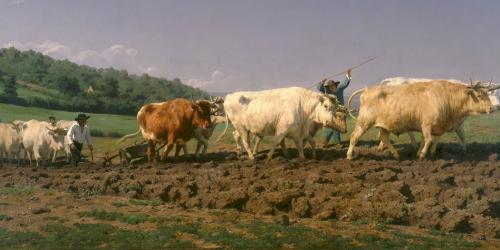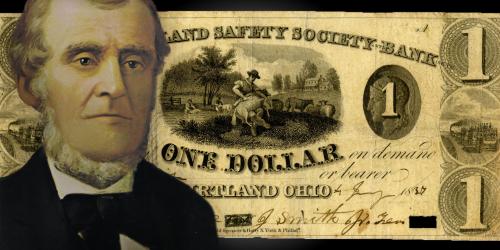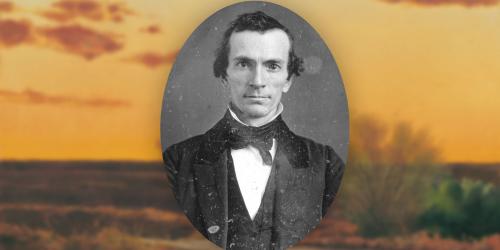June 26, 2024
10 Things You Did Not Know About the Book of Mormon Witnesses
Post contributed by
Neal Rappleye

As Joseph Smith finished the translation of the Book of Mormon, three of his closest supporters—Martin Harris, Oliver Cowdery, and David Whitmer—were chosen by revelation as special witnesses of the Book of Mormon (Doctrine and Covenants 17). An angel showed them the golden plates from which the book was translated (Testimony of Three Witnesses). In addition, eight others were permitted to see and handle the plates and testify of their reality (Testimony of Eight Witnesses).
With the new documentary from A Marvelous Work telling the story of the Book of Mormon Witnesses, here are 10 things you may not have heard before about the witnesses of the Book of Mormon. You may also be interested to see the feature-length film Witnesses produced by The Interpreter Foundation
1. Martin Harris Bore Testimony of the Plates in a Court of Law
Martin Harris is often best remembered for losing 116 manuscript pages of the early translation of the Book of Mormon. Those pages were never retranslated, so their contents are absent from the Book of Mormon to this day. But Martin Harris did much more to contribute to bringing forth the Book of Mormon than many realize, and deserves to be remembered for more of his positive contributions. For example, Martin sold most of his farm in Palmyra (about 150 acres) to pay for the printing of the Book of Mormon.
One of the lesser known stories about Martin Harris is that before he even saw the plates he actually testified of them during a legal proceeding. In March 1829, Martin’s wife Lucy Harris organized the people of Palmyra in opposition to Joseph Smith, bringing a legal suit against him for defrauding the people. Martin knew he would be asked to testify during this trial, so went to Joseph seeking a witness of the plates. Martin did not get to see the plates at that time, but the Lord revealed for the first time that there would be three witnesses and promised Martin that he could be chosen as one of them if he humbled himself (D&C 5). This gave Martin the assurance he needed, and at the trial he testified “And as to the plates which [Joseph Smith] professes to have, gentlemen, if you do not believe it, but continue to resist the truth, it will one day be the means of damning your souls.”
2. David Whitmer’s Fields Were Miraculously Plowed
As Joseph Smith and Oliver Cowdery were translating the Book of Mormon in Harmony, Pennsylvania, they began to face stern opposition. Oliver Cowdery wrote to his friend David Whitmer asking if they could finish the translation at the Whitmer farm in Fayette, New York. David wanted to help but needed to stay and finish plowing the fields before he left. But, the next day, when David went out to begin his work he found that several acres of land had miraculously been plowed.
No one in the Whitmer family knew who had done the labor, but they took it as a sign from God that they should assist Joseph Smith in his work. David immediately traveled the 100 miles from Fayette to Harmony to meet Joseph and bring him and Oliver back to the Whitmer farm.
3. The Three Witnesses Talked Back to the Lord
During their vision of the angel and the plates, the Three Witnesses heard the voice of the Lord command them to “bear record” of their vision and of the truth of the translation as published in the Book of Mormon. According to David Whitmer, however, they were reluctant to do so, and even talked back to the Lord when he issued the command. Oliver reportedly “demurred and told the Lord the people would not believe” their testimony, due to a lack of evidence for “a people who were educated and refined, dwelling in large cities” as described in the Book of Mormon. The Lord promised them “that He would make it known to the people, and people should discover the ruins of the lost cities and abundant evidence of the truth of what is written in the Book.”
In the ensuing years, ruins of large cities and civilizations were discovered in ancient Mesoamerica, and David Whitmer believed these fulfilled the Lord’s promise given to him and the other witnesses on that occasion.
4. Oliver Cowdery was Briefly the Vice President of the Bank of Monroe (in Michigan)
Many are aware that after leaving the Church, Oliver Cowdrey practiced law. Lesser known are the many roles and professions he took on in order to contribute to the Restoration. During his time in the Church Oliver was a scribe, newspaper printer, a writer, a justice of the peace, and more. An especially little-known fact is that he was briefly a banker in 1837.
In 1836, an increasing number of converts were moving to Kirtland in need of land and work, and the Church had accrued significant debts building the Kirtland temple and managing business ventures. To alleviate these pressures, the Church launched a bank called the Kirtland Safety Society in early 1837. This banking endeavor faced several challenges and eventually was shut down later that year.
One of the difficulties was getting a legal charter from the Ohio legislature to operate a bank. After their first attempt at getting a charter was rejected, Church leaders tried another strategy: they bought controlling interest in the Bank of Monroe in Michigan territory, with plans to operate the Kirtland Safety Society as a branch of that bank, because it had a legally recognized charter. As part of the merger, Oliver Cowdery was appointed as the vice president of the Bank of Monroe and briefly served in that capacity before the 1837 banking crisis forced most banks across the country, including the Bank of Monroe, to close.
5. After Leaving the Church, Martin Harris Still Defended the Book of Mormon from Kirtland Dissenters
Despite his early faith and important contributions, Martin Harris was “cut off” from the Church in 1837. As many know, he still did not deny the truth of the Book of Mormon, despite being “at variance with Joseph [Smith].” Few know, however, that he specifically defended the Book of Mormon in a meeting with fellow dissenters from the Church.
Martin was not the only one cut off from the Church in late 1837. A whole group of dissenters led by Warren Parrish believed that Joseph Smith and the Church had lost their way, and these detractors sought to restore the “old standard” in the church. Martin was initially part of their group and given a leadership role within the new church they founded. But in a meeting held in March 1838, leading figures in this movement “renounced the Book of Mormon.” Despite the social pressures to go along with his new peers, “M[artin] Harris arose & said he was sorry for any man who rejected the Book of Mormon for he knew it was true.” He parted ways with those dissenters and continued to affirm the truth of the Book of Mormon over the years.

Fireside on the Book of Mormon Witnesses
Watch a free, virtual fireside on the Book of Mormon Witnesses by retired BYU Professor Susan Easton Black.
6. David Whitmer Eventually Started his Own Church
Among the reasons for David Whitmer’s excommunication was the fact that some believed he was the successor to Joseph Smith, and were pushing him to take over the Church in 1837–1838, because they alleged Joseph was a fallen prophet.
Even after David Whitmer’s excommunication, some continued to believe he was the rightful successor to Joseph Smith. In 1847, after Joseph Smith’s death, former apostle William E. McLellin tried to get David Whitmer to lead a newly organized church, but David did not believe the time was right. It was not until the 1870s that David Whitmer took action to form his own “Whitmerite” church, which initially consisted of just his extended Whitmer family and close friends and neighbors. It eventually expanded to 750 members before slowly fading out in the 20th century.
David’s church was small, but they believed in both the Bible and the Book of Mormon, and David never denied his testimony of the angel and the plates.
7. After Leaving the Church, Oliver Cowdery Regularly Corresponded with His Brother-in-Law, Phineas Young
A few months after Martin Harris was cut off from the Church, a disciplinary hearing was held regarding Oliver Cowdery’s conduct and he was excommunicated. Initially after separating from the Church, Oliver Cowdery may have felt some resentment, but before long sources reported that he was “friendly” toward the Saints. In 1842, he was visited by Phineas Young, husband to Oliver’s half-sister Lucy. After several conversations with Oliver, Phineas reported to his brother Brigham Young that Oliver’s heart “is still with his old friends.”
Over the next several years, Phineas and Oliver had regular correspondence wherein Oliver was candid and open about his concerns and frustrations, but also clearly expressed his yearning desire to return to full fellowship with the Saints. For example, in an 1846 letter he explained that he was frustrated by false charges leveled against him during his excommunication, because he wanted to ensure that “those who might believe in my testimony” of early Restoration events “might not blush for the private character of the man who bore that testimony.”
Throughout his correspondence with Phineas and members of the Twelve, Oliver was friendly and warm toward the Saints, and offered to assist them in legal and political matters. Relations with Oliver were friendly enough by 1843 that Joseph instructed the Twelve in to invite Oliver to rejoin the Church and go with Orson Hyde on his mission to Jerusalem. Although Oliver did not reunite with the Saints at that time, the friendly correspondence with Phineas Young over the years helped prepare the way for Oliver’s return in 1848.
8. Martin Harris Testified of the Book of Mormon in England
Many people know that Martin Harris came out to Utah and rejoined the Church in 1870. Few people are aware of the events that transpired between the time Martin was “cut off” from the Church and his return. In fact, many do not know that Martin was initially rebaptized into the Church in 1842. After the death of Joseph Smith, however, Martin briefly accepted James Strang as the prophetic successor rather than Brigham Young and the Twelve.
As a member of the Strangite Church, Martin went on a mission to England in 1846–1847. While there, he boldly testified of the Book of Mormon, and specifically of seeing the angel and the plates, but he would not support the specific claims of James Strang. Due to this, Strangite apostle Lester Brooks sent Martin home after just a few months. Thanks to this short mission trip, however, Martin became the only one of the Three Witnesses to testify outside of North America.
9. Mary Whitmer was Also Shown the Plates by a Divine Messenger
In addition to Oliver Cowdery, David Whitmer, and Martin Harris, David’s mother Mary Whitmer was also shown the plates by a divine messenger. In fact, she was the first person beside Joseph Smith to actually see the record. While Joseph and Oliver were living with the Whitmer’s and translating the Book of Mormon, their presence added an extra burden of labor onto the Whitmer matriarch. Sometimes she felt the young Prophet and scribe could do more to assist around the house and farm.
One morning, as she was out in the barn doing her chores, thinking that Joseph and Oliver could pitch in a bit more, “carry her a bucket of water or chop a bit of wood” when they took breaks from translating, a stranger carrying a sort of knapsack approached. “[H]e spoke to her in a kind, friendly tone, and began to explain to her the nature of the work which was going on in her house, and she was filled with inexpressible joy and satisfaction.” He then opened the knapsack, revealing the golden plates, and “turned the leaves of the book of plates over, leaf after leaf, and also showed her the engravings upon them.” He encouraged her “to be patient and faithful in bearing her burden a little longer” and promised her blessings in return.
10. Others Also Saw, Hefted, and Handled the Plates
In addition to the Three Witnesses, there were others who saw the plates. Foremost among these are the Eight Witnesses, who saw and handled the plates uncovered and under perfectly ordinary, non-miraculous circumstances. Lesser known to many are the “unofficial” witnesses, who typically did not see the plates directly, but hefted and handled them while covered and could tell by their physical examination that the object Joseph Smith possessed was a set of metal plates.
For example, Emma Smith helped Joseph Smith retrieve the plates and assisted Joseph as a scribe. During that time, she sometimes moved the covered plates around the house as she was cleaning. She once thumbed the edges, and felt that the individual plates were “pliable like thick paper, and would rustle with a metallic sound.”
Learning More
These 10 lesser-known facts about the Book of Mormon Witnesses are just the tip of the iceberg—historical research has revealed a wealth of information on the men and women who saw, handled, and hefted the Book of Mormon plates. Sunday, June 13, Susan Easton Black, retired Church History professor and co-author of the definitive biography on Martin Harris, is giving a free virtual fireside on the Three Witnesses. Join us that evening to learn many more enriching stories about their lives, sacrifices, and testimonies.

















